|
|
![]()
FOREST HEALTH - HARDWOOD SUCKING INSECTS
This group is named because its insects have sucking mouth parts and feed on plant fluids. A huge number of species are included, but few cause actual death to trees. Their main offense is robbing the tree of its food and water. This, of course, can eventually affect growth and health, but most damage is minor. They are also known to spread tree diseases and sometimes the slits they make in branches weaken the branch enough that it dies or snaps off. Evidence of their activity can also appear as defoliation. True bugs are most common order (Hemiptera)
Aphids, Boxelder Bugs, Cicadas, Galls, Lacebugs, Scales
|
| Aphids or plant lice (mostly order Hemiptera): many species, some cultivated by ants for their honeydew, honeydew on willows also attracts bees (especially in the late fall), woolly aphids have conspicuous tufts of cottony masses, aphids insert mouthparts into living plant tissue and suck out the juices, many species are colonial |
| Hosts: most trees, common in aspen and willows |
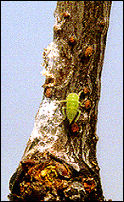 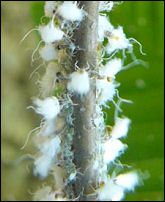 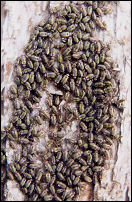 |
Boxelder Bugs (Boisea trivittata, Hemiptera order): not much of a pest on trees but can be a human nuisance, normally feed on boxelder seeds, removing female boxelder trees eliminated food source |
| Hosts: mostly boxelder, sometimes other maples or ashes |
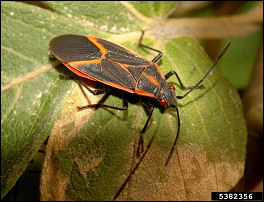 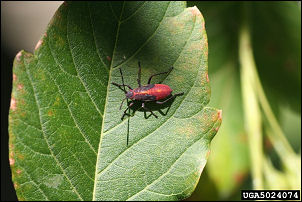 adult (left), nymph (right) |
Cicadas (Magicicada septendecim = periodical cicada): periodically cause mechanical damage to twigs of young hardwoods, at times very numerous, colorful adults, distinctive nymph cases left on many surfaces |
| Hosts: many hardwoods |
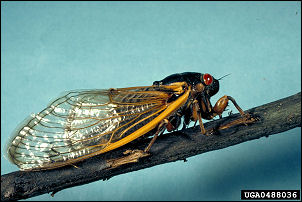 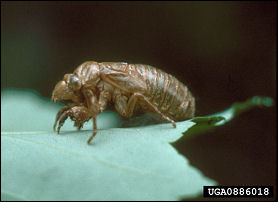 |
Galls: variety of wasps, flies, aphids, and mites, they “sting” a twig or leaf and the swollen, cancer-like reaction provides shelter and food for the insect’s young |
Hosts: many hardwoods and other plants, but particularly ash, oak, poplars, and willows |
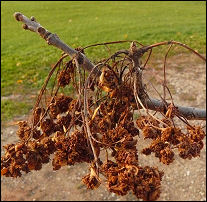 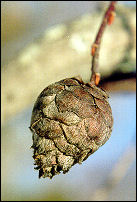 ash flower gall-left 2, oak gall-middle, willow gall-right |
Lace bugs (bug order, Corythucha spp., others): often whitish patches on upper leaf surface, generally harmless, minor damage, feed on leaf undersides |
| Hosts: many hardwoods but especially yellow birch, basswood, maples, ironwood, oaks, and willows |
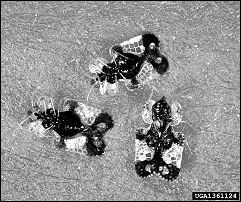 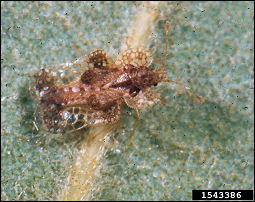 |
Scale insects (mostly true bugs-Hemiptera order): many species, small insects that form hard or soft shells, or sometimes cottony tufts on twigs or leaves, some species are exotics (beech bark disease involves a scale insect, first image) |
| Hosts: nearly all species |
 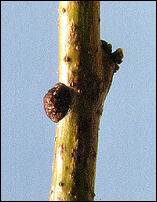 |
Image Citations
Boxelder Bug (1), adult - William M. Ciesla, Forest Health Management International, Bugwood.org
Boxelder Bug (2), nymph - Whitney Cranshaw, Colorado State University, Bugwood.org
Cicada (1) - John H. Ghent, USDA Forest Service, Bugwood.org
Cicada (2) - Tim Tigner, Virginia Department of Forestry, Bugwood.org
Lace Bug, Cherry (1) - USDA Forest Service Archive, USDA Forest Service, Bugwood.org
Lace Bug, Birch, (2) - Jim Baker, North Carolina State University, Bugwood.org
All others - Bill Cook, Michigan State University Extension
Click HERE
to return to the U.P. Tree ID home page.
Click HERE to return to the Forest Health home page.
This site created and maintained by Bill Cook, MSU Extension Forester for the Upper Peninsula of Michigan. Editing and modification is ongoing. Submit suggestions, questions, and corrections to cookwi@msu.edu or call 906-786-1575.